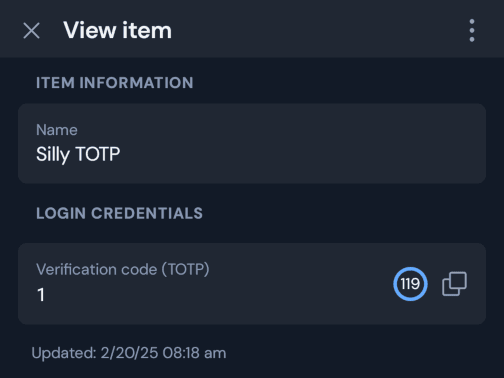If you use Multi-Factor Authentication, you'll be well used to scanning in QR codes which allow you to share a secret code with a website. These are known as Time-based One Time Passwords (TOTP0).
As I've moaned about before, TOTP has never been properly standardised. It's a mish-mash of half-finished proposals with no active development, no test suite, and no-one looking after it. Which is exactly what you want from a security specification, right?!
So let's try to find some edge-cases and see where things break down.
One Punch Man
This is possibly the least secure TOTP code I could create. Scan it and see whether your app will accept it.

What makes it so crap? There are three things which protect you when using TOTP.
- The shared secret. In this case, it is
abcdefghijklmno- OK, that's not the easiest thing to guess, but it isn't exactly complex. - The amount time the code is valid for before changing. Most TOTP codes last 30 seconds, this lasts 120.
- The length of the code. Most codes are 6 digits long. In theory, the spec allows 8 digits. This is 1. Yup. A single digit.

If you were thick enough to use this1, an attacker would have a 1/10 chance of simply guessing your MFA code. If they saw you type it in, they'd have a couple of minutes in which to reuse it.
Can modern TOTP apps add this code? I crowdsourced the answers.
Surprisingly, a few apps accept it! Aegis, 1password, and BitWarden will happily store it and show you a 1 digit code for 120 seconds.
A few reject it. Authy, Google Authenticator, and OpenOTP claim the code is broken and won't add it.
But, weirdly, a few interpret it incorrectly! The native iOS app, Microsoft Authenticator, and KeepassXC store the code, but treat it as a 6 digit, 30 second code.
Do The Right Thing
What is the right thing to do in this case? The code is outside the (very loosely defined) specification. Postel's Law tells us that we should try our best to interpret malformed data - which is what Aegis and BitWarden do.
But, in a security context, that could be dangerous. Perhaps rejecting a dodgy code makes more sense?
What is absolutely daft2 is ignoring the bits of the code you don't like and substituting your own data! Luckily, in a normal TOTP enrolment, the user has to enter a code to prove they've saved it correctly. Entering in a 6 digit code where only 1 is expected is likely to fail.
We're Only Human
A one-digit code is ridiculous. But what about the other extreme? Would a 128-digit code be acceptable? For a human, no; it would be impossible to type in correctly. For a machine with a shared secret, it possibly makes sense.
On a high-latency connection or with users who may have mobility difficulties, a multi-minute timeframe could be sensible. For something of extremely high security, sub-30 seconds may be necessary.
But, again, the specification hasn't evolved to meet user needs. It is stagnant and decaying.
What's Next?
There's an draft proposal to tighten up to TOTP spec which has expired.
It would be nice if the major security players came together to work out a formal and complete specification for this vital piece of security architecture. But I bet it won't ever happen.
- Google have archived their work on authentication standards.
- Apple points to Google's outdated spec.
- YubiCo's incompatible spec hasn't been updated in 4 years.
- The otpauth registration lists a consortium called https://openauthentication.org who don't appear to published anything in a decade.
- Microsoft don't have any documentation whatsoever.
So there you have it. We're told to rely on TOTP for our MFA - yet the major apps all disagree on how the standard should be implemented. This is a recipe for an eventual security disaster.
How do we fix it?
4 thoughts on “The least secure TOTP code possible”
If only the people who designed bitlocker felt this way.
I remember someone saying something about secure locations requiring people to run to their locker, memorise the code, get back to their desk to type it in before it expired. Sounded like some kind of Krypton Factor challenge.
| Reply to original comment on bsky.app
Luckily, it requires just a small bit of common sense in this case to "just don't do that, then": when creating a service, just don't use a one-digit code.
As a slight counterpoint to your "no-one looking after it" argument: the fact that nobody is expanding the protocol beyond its merit is a good thing too. Look what happened to OAuth... The original author ended up being so disgusted by the corporate bloat that he resigned from the v2 working group.
I don't disagree that a better, sensible standard would be great.
@edent
The point I was making isn’t that a single digit code is bad for security, but that having a loosely defined spec which major implementations disagree on is bad for security.
For example, Yubico generate 7 digit TOTP codes. If you move your secrets from their TOTP app to Google, will you be locked out? If you move from Google arbitrary number of seconds to an app which only supports 30 seconds, will your codes occasionally be wrong? Can dodgy URl encoding of certain fields be used to trick or confuse users?
Because major implementations are diverging from the spec and the deficiencies in the original spec, it is possible that unforeseen security issues could arise.
As I say in my post, choosing a single digit TOTP code is stupid. But relying on a stagnant spec is probably worse.
More comments on Mastodon.
What links here from around this blog?